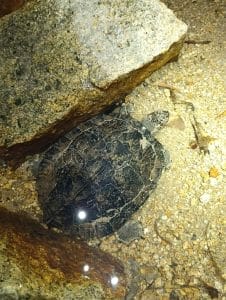Cyclemys dentata (Asian leaf turtle)
Home > Turtle Database > Cyclemys dentata (Asian leaf turtle)
Cyclemys dentata, commonly known as the Asian Leaf Turtle or the Brown Stream Turtle, is a medium-sized freshwater turtle found in Southeast Asia. Known for its distinct serrated carapace, this species is primarily terrestrial but often ventures into shallow water bodies.
Native To These Regions
Bangladesh, Borneo (Malaysia/Indonesia), Brunei, Cambodia, India, Java (Indonesia), Laos, Malaysia, Myanmar, Singapore, Sumatra (Indonesia), Thailand, VietnamNative Turtle Species Map – Find Turtles by Region
Scientific Classification
- Kingdom: Animalia
- Phylum: Chordata
- Class: Reptilia
- Order: Testudines
- Family: Geoemydidae
- Genus: Cyclemys
- Species: Cyclemys dentata
Common Names
- Asian Leaf Turtle
This Hilarious Turtle Book Might Know Your Pet Better Than You Do
Let’s be real—most turtle care guides feel like reading a textbook written by a sleep-deprived zookeeper.
This one’s not that.
Told from the snarky point of view of a grumpy, judgmental turtle, 21 Turtle Truths You’ll Never Read in a Care Guide is packed with sarcasm, sass, and surprisingly useful insights.
And hey—you don’t have to commit to the whole thing just yet.
Grab 2 free truths from the ebook and get a taste of what your turtle really thinks about your setup, your food choices, and that weird plastic palm tree.
It’s funny, it’s honest, and if you’ve ever owned a turtle who glares at you like you’re the problem—you’ll feel seen.
Identification
Description:
Cyclemys dentata has a dark brown to black carapace with a serrated edge at the rear, resembling a leaf, which provides excellent camouflage in its natural habitat. The plastron (underside) is typically yellowish with black blotches. This turtle has a relatively flat shell, and its limbs are covered with rough scales. The head is olive to dark brown, often with yellow or cream-colored stripes.
Sexual Dimorphism:
Males typically have longer, thicker tails and a more concave plastron compared to females, which have a flatter plastron and shorter tails. Males may also have a slightly more prominent shell serration.
Check more turtles from the Cyclemys genus
Native Origin and Distribution
Geographical Range:
Cyclemys dentata is native to Southeast Asia, with its range extending from eastern India through Myanmar, Thailand, Laos, Cambodia, Vietnam, Malaysia, Indonesia, and the Philippines. It is found in a variety of environments, including lowland rainforests and mountainous regions.
Preferred Habitat
This species prefers slow-moving streams, swamps, and shallow ponds within dense forests. It is also known to inhabit marshy areas and rice paddies, where it can find both terrestrial and aquatic food sources. The turtles are highly adaptable and can survive in a variety of microhabitats within their range.
Behavior
Feeding Habits:
Cyclemys dentata is omnivorous, feeding on a mix of plant material, insects, small fish, and carrion. In the wild, they forage both on land and in water, primarily during the morning and evening.
Predators:
Predators of this species include larger reptiles, birds, and mammals. Their camouflage and ability to quickly retreat into water help them avoid predation.
Reproduction
Breeding Season:
Breeding typically occurs during the wet season, when food is abundant, and the environment is most favorable for raising young.
Reproductive Method:
Females lay small clutches of 2-6 eggs in shallow nests dug into the forest floor. The eggs incubate for about 2-3 months before hatching. Hatchlings are independent from birth and have a more rounded shell compared to adults.
Conservation
Extinction Status:
Cyclemys dentata is currently listed as Vulnerable on the IUCN Red List due to habitat loss, over-collection for the pet trade, and consumption in local cuisines.
Threats:
The primary threats to this species are habitat destruction due to deforestation, pollution of freshwater habitats, and illegal poaching for the pet and food trades.
Conservation Measures:
Conservation efforts include habitat protection, captive breeding programs, and legal protection in some parts of its range. Raising awareness about the ecological role and the plight of this species is also crucial.
Economic Importance
Cyclemys dentata is sometimes captured and sold in the pet trade due to its unique appearance and manageable size. However, the demand for these turtles has contributed to their declining wild populations.
Interesting Facts
- The name “dentata” means “toothed,” referring to the serrated edge of the turtle’s carapace.
- Cyclemys dentata is known for its shy and reclusive nature, often remaining hidden among leaf litter.
- Despite being a freshwater species, it spends a considerable amount of time on land, foraging and basking in the sun.

About Author
Muntaseer Rahman started keeping pet turtles back in 2013. He also owns the largest Turtle & Tortoise Facebook community in Bangladesh. These days he is mostly active on Facebook.















